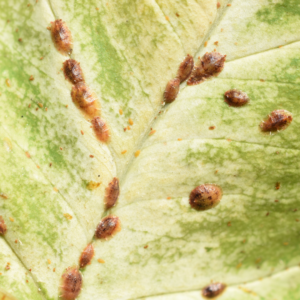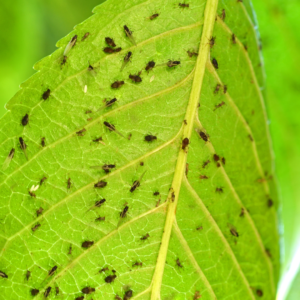Maryland & Northern Virginia Tree And Shrub Health Problems

Trees and shrubs are among the most expensive investments you’ll likely make in your lawn. However, when they are not appropriately maintained, trees and shrubs can negatively impact the overall beauty of your property and its value. Protect your investment with the right care, including proper nutrition, protection, and frequent attention so they can thrive.
Insects, poor soil conditions, and weather can destroy your ornamental trees and shrubs throughout the seasons. Knowing what to look for and when is critical to preventing any health, insect, or disease issues before they occur.
By partnering with our team of specialists, we will determine the necessary treatments using our extensive knowledge and experience to address the needs and risks threatening each tree and shrub.
11 Issues That Affect Trees And Shrubs in Maryland And Northern Virginia
Scale Insects
 Scale insects are generally found on hardwoods and conifers. Some varieties are easily detected, while others require expert identification. If you notice a sooty mold or ants on the tree (in large numbers), there is a possibility of an infection. Leaves turning yellow or red or abnormal growth at the point of the attack by the scale insect are clear signs. Heavy infestations will kill your tree.
Scale insects are generally found on hardwoods and conifers. Some varieties are easily detected, while others require expert identification. If you notice a sooty mold or ants on the tree (in large numbers), there is a possibility of an infection. Leaves turning yellow or red or abnormal growth at the point of the attack by the scale insect are clear signs. Heavy infestations will kill your tree.
Winter Injury
This is one of the more common problems trees and shrubs in our area are affected by. Winter injury is caused by moisture loss throughout the plant, making them more susceptible to the harsh elements. Your soil freezes throughout the winter, and the moisture becomes locked in and can not be distributed to the plant’s roots. We recommend using anti-desiccant sprays as one method to help your trees and shrubs survive the winter months.
Aphid Insects
 The Aphid insect is often called a honey-dew because they secrete a sticky sap-like liquid that will coat sidewalks, cars, and patio furniture. These insects are small, pearl-shaped, soft-bodied bugs with two cornicles (the cornicles are wax secreting). When plants suffer from an Aphids infestation, the leaves turn yellow and fall off the stems. The aphid collects in large numbers on the underside of leaves. As a result, a black sooty mold will develop on the stems of the plants.
The Aphid insect is often called a honey-dew because they secrete a sticky sap-like liquid that will coat sidewalks, cars, and patio furniture. These insects are small, pearl-shaped, soft-bodied bugs with two cornicles (the cornicles are wax secreting). When plants suffer from an Aphids infestation, the leaves turn yellow and fall off the stems. The aphid collects in large numbers on the underside of leaves. As a result, a black sooty mold will develop on the stems of the plants.
Mites
Mites are not insects; they are spiders. They have eight legs and will usually be found on the underside of the leaves. Mites attach themselves with their sucking mouthparts. Often mites are found on small evergreens and thrive in hot, dry weather. Once the mites have grown in numbers, the damage can be seen easily as defoliation begins to occur quickly.
Anthracnose Disease
Dogwood trees throughout Maryland and Northern Virginia are highly susceptible to this disease. The first sign of anthracnose is spotting the foliage in late spring and summer. Left unchecked, the dogwood will develop cankers on the branches. The cankers will girdle the tree and kill the dogwood. Most often, this disease is found in heavily wooded areas.
Borer Insects
Borers target weakened trees with heavy defoliation from tent caterpillars. Trees in decline tend to produce natural chemicals that will attract the borer. In this case, the best defense is a healthy tree. A tree adequately maintained, fertilized, and pruned has a lesser chance of any borers invading.
Hemlock Woolly Adelgid
Hemlocks left untreated will die if there is an infection of the woolly adelgid. When a mature hemlock tree has this insect, there will be a tell-tale sign: an invasion of small ‘cotton balls’ pasted to the underside of tree branches and twigs. The good news is that you can control this disease relatively easily. So be on the lookout and call for professional help if you see ‘cotton balls’ on your hemlock.
Lace Bugs
Lace bugs prefer azalea, rhododendron, and and andromeda. They like their host plants to be in full sun if possible and will grow to be about 3-4mm in length with wings that look lacey. The topsides of infected leaves will appear to have silver to yellow stippling, while the underside of the leaf will have black to brownish spots (looking something like a varnish). Lace bugs must be found early because there are no natural enemies to control the population and will become difficult to eliminate.
Tent Caterpillars
Tent caterpillars have a voracious appetite for the leaves of ornamentals. One tent can house thousands of these bluish caterpillars that don a black head and a white strip down the back. Unfortunately, they cause defoliation, resulting in a weakened tree more susceptible to wood-boring insects.
Rose Sawfly
 Rose sawfly damage usually appears early to mid-May and can continue through mid-June.
Rose sawfly damage usually appears early to mid-May and can continue through mid-June.
Damage caused by rose sawflies is cosmetic and will not have serious long-term effects on your rose plants. However, the leaves will brown and dry, severely reducing the aesthetic value of the shrubs.
Weevils
One of the worst insects to deal with is the weevil! Weevils have an elongated head and a protruding curved snout. The weevil is nocturnal and causes damage in two ways:
- Mature weevils will cause damage to leaves. Adult weevils cannot fly, and therefore the spread isn’t as quick.
- Younger weevils will cause damage at or below the surface and roots. Once the roots of a plant have been girdled, the plant will die because it will not be able to transport water.
Weevils must be treated professionally.
Get started with a personalized plan that will help to enhance the overall health and appearance while also protecting your trees and shrubs. Learn more on our tree and shrub page.
Have a Question About Lawn Care? Ask the Experts!
Having a tree or shrub problem that you can’t seem to solve? Send your question to our expert technicians and get the answers you need to get a healthy, beautiful lawn.
Ask a Lawn Care QuestionConsider Professional Lawn Care
End the guesswork and stress of lawn maintenance. Let our experienced team put their expertise to work making your lawn healthy and beautiful.
Get a FREE Lawn Care Quote Now
Quick Quote Form
"*" indicates required fields
